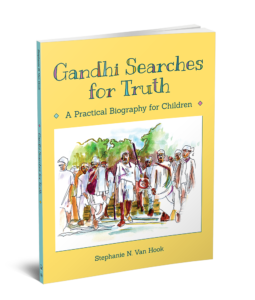After fielding some commonly asked questions about my new book, Gandhi Searches for Truth: A Practical Biography for Children, I thought it’d be useful to post my answers here, so that others may learn more about the book and Gandhi. Have questions about bulk orders for your school, bookstore, or library? Please email me for details: stephanie@mettacenter.org.
Why is it a “practical” biography? What is “practical” about it?
Gandhi referred to himself as a “practical idealist.” He wanted to take big ideas, like nonviolence, Truth, love and equality, and work them out in practice. At the same time, Gandhi is only practical if we understand and really take to heart that he was a human being, like us. We don’t have to think of Gandhi as though he were just a figure for the history books–we can look to him to empower ourselves to be brave enough to try things differently when necessary.
For what age group is this book intended?
I wrote Gandhi Searches for Truth as a tool to help me talk about Gandhi to the 3 to 6 year- olds with whom I spend my time as a teacher in a Montessori preschool/kindergarten. However, for that age group, it is meant to be read slowly or even processed first by the grown-up and retold in a way that works for the child. Each “chapter” can kindle a big conversation, about Gandhi’s life, about the lessons of nonviolence in the chapter, and even just about the words used—what do they mean to us personally, what about when we express these ideas with others? That said, the bond that can form between the grown-up and child motivated the format of this book.
At the same time, children of older ages (or those who are young at heart) will find material in this book useful. From quotes to ponder about the big ideas that Gandhi espoused, to a better understanding of Gandhi’s life and career, to some clarifying ideas about nonviolence, any reader will find something in this book to enjoy—and something to make them think deeply.
Are there other resources associated with this book?
There are! First of all, at the Metta Center, we’re working on a curriculum to accompany the book, which should be ready in a few months, and a year-long peace curriculum for an early childhood classroom, which should be ready in about a year’s time. Secondly, we have materials on our website dedicated to parents, educators, and activists. Feel free to contact the Metta Center at any time with any questions that come up, or if you would like to be involved.
I want to use a mantram as Gandhi did, but I don’t know how to begin.
To learn more about the use of a mantram, and how to use a matnram from your own tradition, you can check out Eknath Easwaran’s Mantram Handbook, or visit this page to learn more.
Where can I learn more about Gandhi?
Gandhi’s collected works run to more than 100 volumes. But practically speaking, I recommend reading his Hind Swaraj, Indian Home Rule and/or Satyagraha in South Africa along with one of the really good anthologies, like All Men are Brothers and Eknath Easwaran’s Gandhi the Man. To learn more about nonviolence, check out Michael Nagler’s Search for a Nonviolent Future. For putting Gandhi’s ideas into action, see Nagler’s Nonviolence Handbook: A Guide for Practical Action.
How can I order the book?
I’m happy to help! I’m donating 100% of the sales proceeds to the Metta Center for Nonviolence. You can support the Metta Center too: donate $10 or more per month, and I’ll send you a signed copy of the book (with a personalized message). Gandhi Searches for Truth is also available at the Vedanta Society bookstore in San Francisco, Point Reyes Books in Point Reyes Station, and Many Rivers Bookstore in Sebastopol, California. If you’re an educator—or if you run a bookstore or library—you can order the book in bulk quantities for a discount. Please email me about that: stephanie@mettacenter.org.









